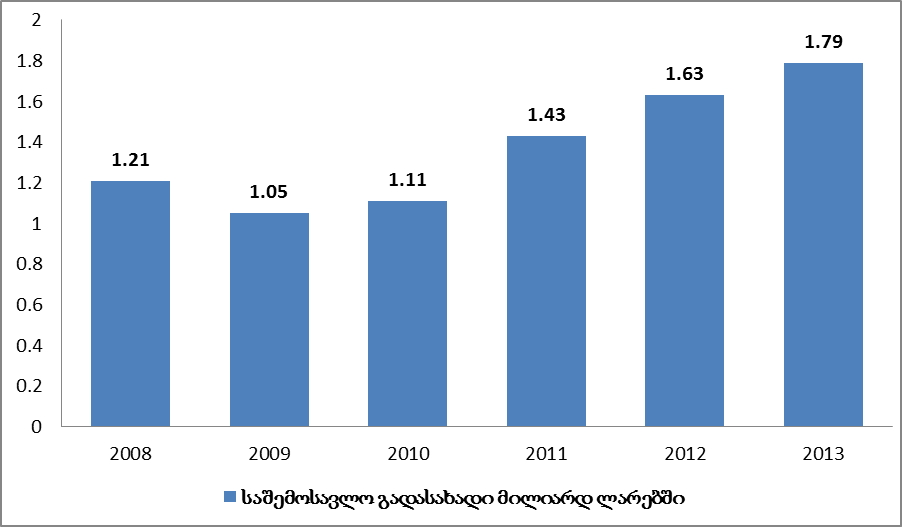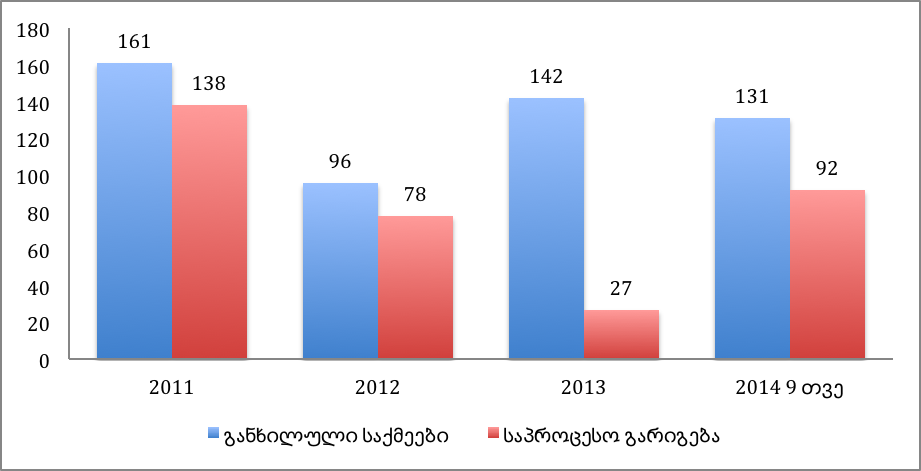On 1 October 2014, during the session of the Parliament, Parliamentary Minority MP, Giorgi Gabashvili, stated that Georgia is still among the poor countries by the GDP per capita and holds the 118th position in the world. He also pointed out that with a 5% growth, as planned for the current year, it will take 50 years to double the GDP.
FactCheck took interest in this statement and verified its accuracy.
The GDP per capita (income per person) is calculated by the ratio of the GDP of the country to the number of its population and is often used in order to assess living standards.
The nominal GDP of Georgia amounted to GEL 26.8 billion in 2013. The nominal GDP per capita equalled GEL 5,983 (USD 3,597) in 2013 whilst the real GDP (2003 prices) amounted to GEL 3,345 (USD 2,011). The GDP per capita was equal to GEL 1,972 (USD 919) in 2003. Hence, the real GDP per capita has grown 1.7 times since 2003 whilst the nominal GDP has tripled.
The GDP per capita depends upon the growth of the GDP as well as the growth of the population of the country. According to the data of the National Statistics Office of Georgia, the population of Georgia has grown by 3.4% from 2003 to 2013 whilst the real GDP has grown 1.75 times. Hence, we can conclude that the growth of the GDP per capita was due to the economic growth.
As the MP pointed out, the planned rate of the GDP growth is 5% in 2014 whilst the population growth has been 0.34% during the past ten years. Assuming that the population growth rate remains the same, it will take 16-17 years to double the real GDP per capita with a 5% growth whilst it will take 11-12 years to double it in terms of a 7%-8% growth.
Latvia has the lowest GDP per capita, at USD 15,187, among the high-income countries of Europe. In order to reach the levels of Latvia with a 5% GDP growth, Georgia will need a minimum of 33 and not 50 years as stated by the MP. However, given the fact that the GDP per capita in the European countries will probably be higher than it is today, the 50 year period is more realistic.
The GDP per capita by purchasing power parity (PPP) gives a more accurate image of the welfare of a country. When using this method, the purchasing power of USD 1 is the same for all countries. Hence, purchasing power parity excludes the differences in currency rates and prices. This gives a more accurate image of the welfare of a country and makes it easier to compare it with other countries.
Chart 1 depicts the GDP per capita dynamics from 2003 to 2014. As the chart makes clear, the GDP per capita has indeed doubled since 2003.
Source: International Monetary Fund
Various international organisations create rankings of countries based upon the GDP per capita. There might be slight differences in the statistics published by different organisations due to a different methodology and sources of information; however, most of the time this difference is insignificant and does not change the general image.
According to the World Bank, Georgia held the 166th position by the nominal GDP per capita in 2003; however, it gradually improved its ranking, reaching the 136th position by the GDP per capita of USD 3,602 in 2013. According to the International Monetary Fund, Georgia holds the 116th position by the GDP per capita of USD 3,597 whilst it held the 129th position in 2003.
As pointed out above, the GDP per capita by purchasing power parity is a much more accurate tool for comparing the welfare of different countries. With the GDP per capita by purchasing power parity Georgia held the 123rd position in 2003 (USD 3,429) moving to the 118th position in 2013 (USD 7,156). The chart below reflects the changes in Georgia’s rating from 2003 to date.
Source: International Monetary Fund
Conclusion
The nominal GDP per capita of Georgia amounted to GEL 5,983 (USD 3,597) in 2013. It held the 116th place in the rating of the International Monetary Fund. Based upon the GDP per capita by purchasing power parity, Georgia held the 118th position with USD 7,156.
As for the real GDP per capita, it equalled GEL 3,345 (USD 2,011) in 2013. The expected economic growth rate of 2014 is 5%. It will take 16-17 years in order for the GDP per capita to double with this growth rate whilst it would take 11-12 years if the growth reached 7%-8%.
It should also be pointed out that Latvia has the lowest GDP per capita, USD 15,187, among the high-income countries of Europe. In order to reach the levels of Latvia with a 5% GDP growth, Georgia will need a minimum of 33 years.
FactCheck concludes that Giorgi Gabashvili’s statement: “Georgia is still among the poor countries. The GDP per capita equals GEL 6,000 with a total of 118 countries ranking higher. We doubled the GDP per capita after 2003. A minimum of a 7% or an 8% growth is necessary in order for this figure to double again; however, there is no such growth nor is it planned. We shall need 50 years to reach the minimum European standard,” is TRUE.

“Georgia is still among the poor countries. The GDP per capita equals GEL 6,000 with a total of 118 countries ranking higher. We doubled the GDP per capita after 2003. A minimum of a 7% or an 8% growth is necessary in order for this figure to double again
30/10/2014
True
The statement is accurate and nothing is missing
Persons
-

“Caring for emigrants is a priority of o...
FalseThe statement is inaccurate -

“The average teacher salary increased by...
Mostly TrueThe application is accurate, but requires additional information and/or definition -

“Passenger traffic at airports has incre...
Mostly TrueThe application is accurate, but requires additional information and/or definition





